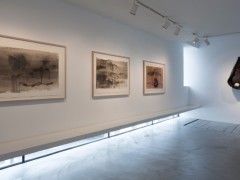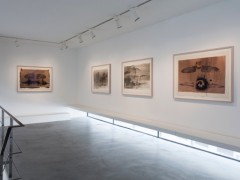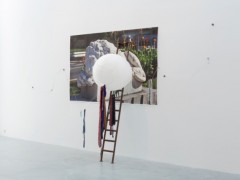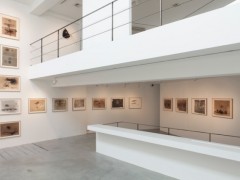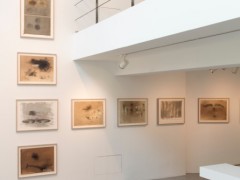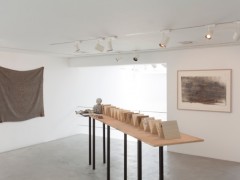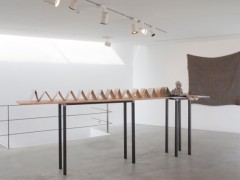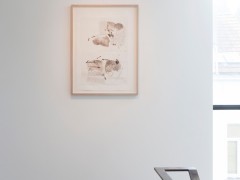Ricardo Brey – Kicking the can down the road
10.09 – 25.10 / 2014
Nathalie Obadia Gallery, Brussels
The Nathalie Obadia Gallery, Brussels, is pleased to present a solo exhibition by Ricardo Brey, the Cuban artist, now living and working in Belgium, thus rekindling historical ties, as the gallery exhibited his work for the first time in Paris in 1994.
Jan Hoet discovered Brey’s work in 1990, at the 3rd Biennial in Havana (Cuba) and Brey’s international career began in earnest two years later with his participation in the Documenta IX Kassel (Germany). Today, Ricardo Brey is celebrated on both sides of the Atlantic.
As his retrospective at the Fine Arts Museum in Havana comes to a close, preparations for his ambitious solo exhibition at the Museum of Contemporary Art in Anvers (M.H.K.A.) for 2015, are beginning. This solo show will be the fruit of 20 years of work and collaboration between Ricardo Brey and Bart de Baere, current director of the M.H.K.A.
Ricardo Brey was born in 1955 and, 23 years after having left Cuba, he remains a “cult” artist in his country of origin. He became part of Cuban art history in 1981 with his participation in Volumen I, the first exhibition in Havana by the collective of the same name constituting, without realizing it (youthful insouciance), the founding act of contemporary art in Cuba. The break with the past was spectacular; the artworks exhibited at the Volumen I testified to the experimentation, for the first time, of conceptual art in marked contrast to traditional mediums such as painting and sculpture.
The movement, which was launched by Ricardo Brey and his friends, Juan Francsico Elso and José Bedia, embodied “a crisis in convictions” at the beginning of the 1980’s, which the historian Gerado Mosquera called the “anthropological trend in Cuban art,” combining mysticism, religion and anthropological concepts inspired, in particular, by the “Pensée Sauvage” of Claude Lévi-Strauss, one of Ricardo Brey’s favorite authors.
In 1985, the young Cuban artist withdrew to share the miseries of daily life in the marginalized community of the Indians of South Dakota (USA). This experience, as painful as it was significant to his later life, pushed Ricardo Brey to draw on his “tigertude” to find inspiration in the great forces of nature as did the Native Americans, who saw life in all things. From then on, his art was guided by a “holistic vision of the world,” in which everything that nature produces (plants, minerals, fragments of animals) or that is manufactured in the form of recycled forms, is reincarnated and becomes worthy of use as material for creation. Sorted, transformed and assembled, the objects take on a new life under the effect of Ricardo Brey’s fertile imagination, thus acquiring a symbolic, and aesthetic nobility, which is magnified by his sharp sense of composition and staging.
Having inherited Afro-Cuban beliefs tinged with animism, Ricardo Brey gives all of his creations a strong spirituality which transforms the everyday into the sacred. The result is work that has a totemic dimension, in which life always runs alongside death. This rich duality can be found in the work of Théodore Géricault (1791-1824) whose romantic maestria had the ability to touch the soul while staying on familiar terms with horror, as in Radeau de la Méduse, the masterpiece that profoundly influenced Ricardo Brey, who nevertheless refused to fall into morbidity. For Brey, the construction/destruction duality which underlies his creations, illustrates the vitality which, on the contrary, brings his work to life. For example, the installation (Sans-Titre) that he presented in 1992, at the Documenta IX, associated fragments of animals put into motion by the air currents created by fans. For Brey, this airborne ballet of feathers and ribbons was in and of itself a negation of death, and this installation for Kassel, like those which come after it, is free of “the common inertia of still lifes.”
Ricardo Brey’s ode to life embodies itself most eloquently in the recycling of even out-of-date objects, a unifying thread of his poetic and spiritual body of work. This practice, which gives a second life to disparate materials, maintains a historical connection to Duchamp, Joseph Beuys and Arte Povera, all sources of inspiration for the Cuban artist. Brey’s works, which at first glance look chaotic, all flirt with the idea of accident, fortuitous encounters between materials, forms and textures, which happen against all odds; but these confrontations, arranged in space by the artist, create meaning and give form to a personal mythology in constant evolution.
Brey’s imaginary world is illustrated most intimately in his series of boxes Every life is a fire, begun in 2009. Their exhibition, codified by a determined ritual, is a sort of performance. The displayed boxes are designed to interact with the viewer, who discovers boxes inside boxes like Russian dolls, which as they are opened, reveal the cleverly constructed and utopian world of Ricardo Brey little by little. The artist describes his “reliquaries” as Lagerstätten, the German term used by paleontologists to designate the geological strata that provide information on the biodiversity of a given period. The scientific term is highly appropriate for those who want to open, layer by layer, Ricardo Brey’s Pandora’s box.
The exhibition also presents a selection of about twenty drawings, which are part of the continuation of two concomitant graphic projects: Universe (2002-2006), an enormous project which compiles 1,004 drawings, all exhibited at the S.M.A.K., Gand in 2006-2007 and published, for the occasion, in a 500-page volume. Universe looks like an encyclopedia of the various materials and techniques that the artist has used over the past 30 years. Annex (2003-2009), the second project, is made up of recurrent motifs in Brey’s work including fish, birds, insects, plants and the moon. Together they plunge us into an ocean of ink and paper, inhabited by the abyssal dreams of its creator.
Last but not least, Ricardo Brey’s latest pieces, use photography to build associations between objects he recycles in order to compose something like “photo-sculptures” which are subjected to the same staging tricks as his installations, like his snapshots of tree trunks currently exhibited at the Fine arts museum of Havana. In this series, the importance given to detail, reinforced by the format size and printing technique on canvas, is in the tradition of Ricardo Brey’s typically naturalistic approach. The Cuban artist calls his process “organic” as he (we must remember) believes that there is life in all things. Ricardo Brey, like a Shamanic demiurge, demonstrates this principle each time a little more in every one of his new artistic experiments.
This post is also available in: Spanish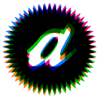

 Home
Home
